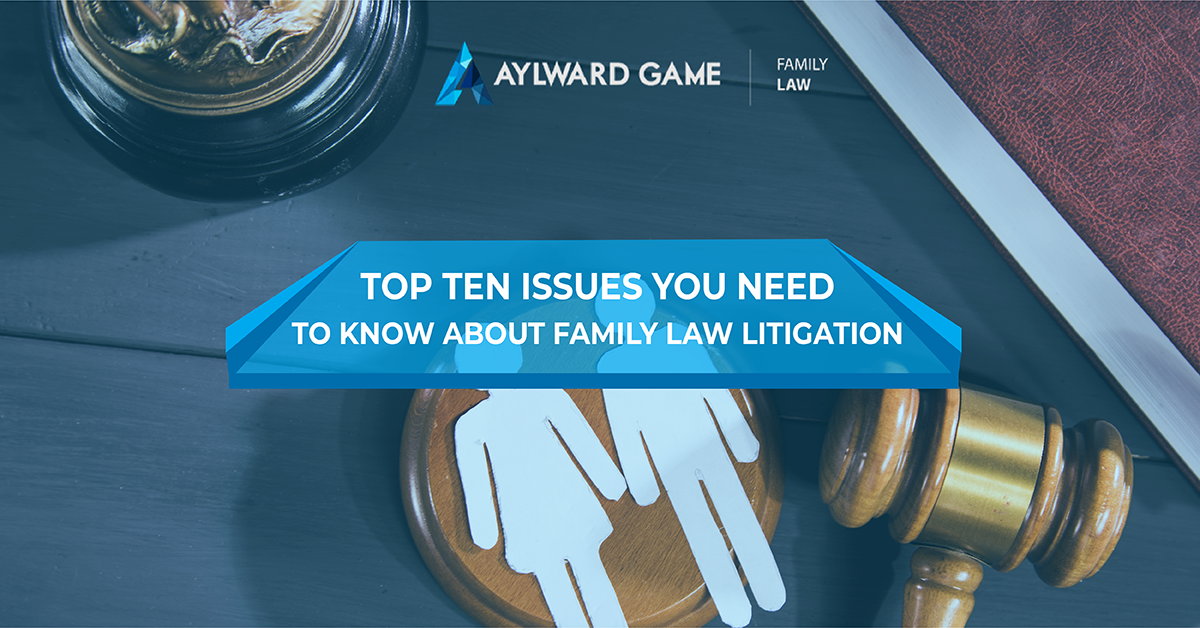Top Ten Issues You Need To Know About Family Law Litigation
Follow along for the latest installment of our ‘TOP TEN ISSUES YOU NEED TO KNOW” series. This feature discusses the Top Ten Issues You Need To Know About Family Law Litigation. In 1975 the Federal Government set up the Family Court to deal with matrimonial matters. It now also deals with de facto and same-sex […]

Top Ten Issues You Need To Know About Family Law Litigation
Follow along for the latest installment of our ‘TOP TEN ISSUES YOU NEED TO KNOW” series. This feature discusses the Top Ten Issues You Need To Know About Family Law Litigation.
In 1975 the Federal Government set up the Family Court to deal with matrimonial matters. It now also deals with de facto and same-sex relationships. Prior to 1975, the State Supreme Courts had jurisdiction in regard to issues resulting from a breakdown in a marriage. De facto couples and same-sex couples had no representation in this Court. Under the Matrimonial Causes Act, it was necessary to establish a fault to bring matters before the Court, such as cruelty, desertion, separation for a lengthy period of time, and other such matters. The requirement to establish these grounds was abolished and parties can now have matters dealt with in the Family Court as soon as separation occurs in their relationship. There is a requirement for a separation of 12 months to bring an Application for Divorce but that does not prevent applications in relation to property issues and children from being filed with the Court immediately after a separation has occurred.
Disadvantages of Family Law litigation
- There can be lengthy delays in having the matter dealt with by the Court. It is not unusual for a matter to take 15 months to 2 years for a final determination to be made by the Judge. The parties can at any time reach an agreement on the issues before the Court and have orders issued by way of consent.
- Family Law Litigation including Family Court proceedings can be costly. There are requirements for the filing of applications and affidavits and other documents and these documents must be properly drafted if the matter is to proceed through the Court. The parties have separate representation. The solicitors receive varying instructions which can create conflict in the conduct of the matter which draws out the process of reaching a speedy resolution.
- Proceedings in the Family Court are emotionally draining for the parties. Friends and family can be drawn into the process creating relationship difficulties. It is an adversarial process that does not assist in a conciliatory resolution of the issues before the Court.
- The parties in Family Court litigation have no control over the process. Dates are set for the mentions and various hearings of matters before the Court. If the parties are unable to resolve their matters then a judgment will be forced upon them at the conclusion of the matter by way of trial. The judgment may not be to everyone’s satisfaction. The parties are subject to examination, cross-examination, and re-examination during the trial process and it can be a harrowing experience for those involved.
- The parties have no control over the running of the matter through the Court process and are required to comply with directions and orders made and for appearances on dates set by the Court.
- Legal representation is not necessary for the running of a matter in the Family Court. Self-litigants however do not have the knowledge required to meet all the requirements that are imposed upon them for the proper conduct of their matter and the drafting of their Court documents. It is not an easy process to follow and self-litigants may not have the ability to properly present their evidence to the Court nor to comply with the requirements for the drafting of the application and other Court documents.

Advantages of Family Law litigation
- Court orders made by the Court are enforceable and this provides some certainty to the resolution of financial issues and children’s issues arising from a breakdown in a relationship, leading to family law litigation. Court orders are enforced in the Court.
- Where there is a real concern in regard to the parenting of the children an Independent Children’s Lawyer can be appointed by the Court to solely look after the children’s interests. An Independent Children’s Lawyer is funded by Legal Aid although the parties may be requested to contribute to a small degree to the costs of the children’s lawyer. The children’s lawyer has the ability to obtain relevant information from doctors, hospitals, schools, and other sources. As well a Family Report may be prepared at the request of the children’s lawyer. The Court can also order a Family Report without the appointment of a children’s lawyer. The Report Writer will then interview the parties with the children if that is appropriate and present a detailed report with recommendations for a resolution of parenting issues. The Judge hearing the matter will make his or her own assessment of those recommendations. The information obtained by the Independent Children’s Lawyer reduces the costs of the parties personally obtaining such documentation and information.
- There is a requirement in relation to parenting matters for the parties to attend a mediation prior to the institution of proceedings in the Court unless there is some element of urgency in bringing this application. The Federal Government has set up Family Relationship Centres which provide this mediation service without cost to the parties. This is a very valuable means of resolving parenting issues or if not reaching a resolution of minimising the matters which then go to the Court.
- An application for divorce can be filed 12 months after the date of separation. The parties have 12 months after the order for divorce is made by the Court to resolve financial issues otherwise leave of the Court must be obtained. It is a no-fault divorce application.
The Devastating Effect of COVID-19 already being Felt in Aussie Family Law Courts





SHARE THIS